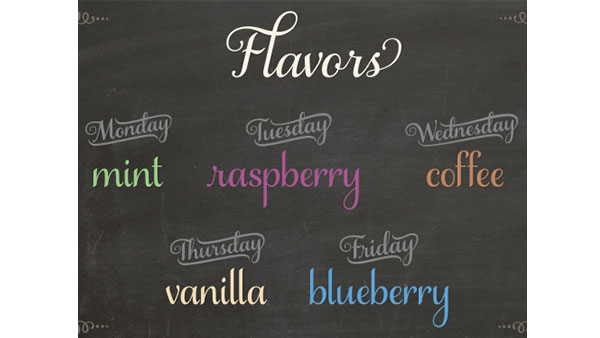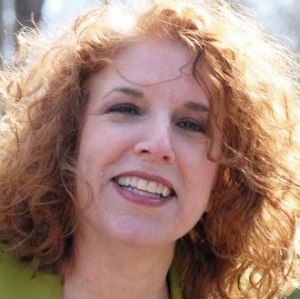TypeTalk: Laura Worthington, Script Designer Extraordinaire

Scripts have become some of the most popular typestyles in use today. They can be seen on everything from book covers and magazines, to ads, invitations, and logos, as well as web sites and other digital media. One of the most accomplished and prolific designers of these decorative, expressive typefaces is Laura Worthington. Laura’s passion for her craft, her finely-tuned aesthetics, merged with her technological skill, have given rise to some of the most beautiful and lovingly-crafted typefaces of their kind.
With a background in graphic design, calligraphy and typography, this award-winning typeface designer is responsible for typestyles that are stylish, organic, and uniquely original. While some are quirky, edgy, and rustic, others are graceful, lyrical, and even romantic. Many come with an expansive set of alternates, allowing the designer to customize each setting. A number of the larger families contain as many as ten distinctive yet related designs – some with catchwords, flourishes, banners, frames, and ornaments – all of which provide the designer with unlimited options for creativity in not just the setting of the words, but the look of the entire piece.
In her own words, here is a little more about Laura – her inspiration, process, and motivation:
How did you get started in typeface design?
I had long been interested in typeface design, and had purchased a copy of FontLab in 2005. I had experimented with it from time to time, but it wasn’t until December of 2009 that I did anything serious with it. I had been a freelance graphic designer for several years, and time was a luxury – and from talking to friends who had designed typefaces, reading articles, interviews, etc., I had an idea of how long it could take to design a typeface. However, at the end of 2009, I was in an unusual place with my career and my life. Clients were hard to come by and my interest in graphic design was waning. I always wanted to do more with lettering and type, and for the first time in years, I actually had some rare free time to pursue it.
I got together with my friend Charles Borges de Oliveira, who showed me some of the basics of FontLab. I was absolutely inspired by his tutelage and success as a typeface designer, and I spent the next month designing my first typeface, GrindelGrove. I read books, online articles and frequented Typophile.com to learn as much as I could about the craft, and finally published my first font in December of that year. I knew early on that I was on the right path and that type design was IT for me, and I spent the next nine months burning the midnight oil to get to a place where I could be a full-time typeface designer. I was designing and publishing typefaces, working a part-time graphic design contract job, teaching design part time, and working with a dozen freelance clients. I look back at that time in my life and wonder how I made it through. But motivation, and finding your life’s work and passion is quite a powerful thing!
GrindelGrove, the designer’s first commercial typeface, is based on brush lettering drawn on watercolor paper for a native plant habitat garden brochure.
What inspires your designs?
Many things, however, the biggest inspiration comes from the pleasure of bringing something to life from the tiniest spark of imagination. I’ll sit down to do some lettering and suddenly a letterform comes out of seemingly nowhere that initiates an idea, a feeling, a memory. All of the possibilities of what I can do with it that lead me to a fully fledged concept, which then turns into a typeface. I’ve known many type designers to have a more straightforward process, where they decide upon a concept, develop a creative brief, and design their typefaces according to the criterion they’ve set for it. I do this from time to time, but most of the time it’s a very intuitive process and would take a lengthy and somewhat disjointed explanation of how I got from here to there.
What is your process?
I begin by lettering, or less frequently, sketching an alphabet on grid paper, and scanning in what usually ends up being several pages of letters, numerals, punctuation, etc. From there, I pick the best representation of each character. Then in Photoshop, I use the lasso tool to select it, copy/paste it into FontLab, and use the pen tool to redraw it. I work with just the lowercase first and spend as little time as possible redrawing the letterforms in FontLab. I work this way because I find that most of the time what I’ve lettered doesn’t translate well into a typeface and I either need to ditch the entire concept or go back to the drawing board to recreate the lettering in a way that will work. I’d say that about two thirds of my initial designs get abandoned entirely, and of the remaining third, more than half of that will get a complete lettering makeover; the rest work well right out of the gates.
Rosarian is a bold, lush, yet playful script originally drawn with a pointed brush, which resulted in some interesting forms through the manipulation of the brush.
Hummingbird comes in two weights, both of which have numerous decorative alternate characters, including many with a floral motif, as shown above.
Once I get a design going that I know will work, I proceed to refine the lowercase until it’s about 90% finished. I’ve found that lowercase and uppercase letterforms have to be treated differently as they have different forms and functions. With lowercase letters, a sense of rhythm and harmony are essential; uppercase letters can have more personality, and be used more as a focal point.
Once I’ve finished the upper and lowercase forms, I move on to punctuation, then numerals, special characters, swashes, alternates and diacritics. Then its on to kerning, defining OpenType features, testing, and finally, all of the other parts needed to market and promote a typeface – designing specimens, writing descriptions, and so on.
Are connecting scripts hard to design?
Absolutely. Certain letters don’t lend themselves to natural connections such as the cursive r, s, x and z in particular. They all have entrance strokes, whereas the other forms generally don’t, which mean they tend to have more space to the left of them and can cause unsightly gaps. Also, the connections themselves have to work perfectly together, so I find myself spending
a disproportionate amount of time getting that right. I find semi-connected scripts to not only be easier to design, but more realistic and natural looking as well. However, semi-connected scripts tend to be more informal so depending on the goal of the design, it’s not always an option.
Which is the design with the largest number of characters, and why are there so many?
Samantha Script has the largest number of alternate letterforms – over 1100 unique designs, totaling over 2700 glyphs. I wanted to give the end user a massive array of choices so that they could use it to fit many purposes in their design work, from a simple to highly complex styling. Part of my motivation as well was to see if it was something designers would want, be interested in, and find useful. And to challenge myself as well – which worked! It was mind boggling to come up with that many ideas!
The Samantha Script family contains both an upright and an italic version in two weights each, as well as ornaments and catchwords, making it very versatile and a lot of fun to use.
Which was the hardest to design?
For individual designs, that would be Hummingbird. The goal was to create a typeface that would mimic natural handwriting/lettering as closely as possible. With the contextual alternates feature on, about 65% of the letterforms substitute to a better suited alternate which presents the most ideal script joining behavior for that combination of letters. They also provide a sense of randomness: repeating letters (i.e.; ll, nn, gg) substitute to an alternate letterform, preventing them from having that all too noticeable, “canned” font look. Some letterforms have exit strokes that drop below the baseline instead of connecting, and so on. I did as much as I could to keep it looking fresh and unexpected. Exploring all of the different letter combinations and creating alternates for each as well as designing additional features to generate a more organic random quality was quite taxing.
These initial sketches for the Adorn family led to a superfamily consisting of four script fonts, nine display fonts, three monogram styles, ornaments, frames, banners and catchwords – quite the ambitious endeavor!
Adorn (which is a collection of four script fonts, nine display fonts, three monogram styles, ornaments, frames, banners and catchwords) was also incredibly challenging. I wanted to cover all four corners of the modern lettering/calligraphy look and feel, while achieving a sense of harmony throughout, regardless of what combination one chooses within the collection. It’s a tall order, and one that contradicts itself at times. All of the letterforms need to be distinct, yet look like they go together. And then there were the monograms! It was a stretch to find a way to make complex letterforms and ornamentation work harmoniously, particularly the three letter monograms!
What kind of designs would you like to do in the future?
Anything that challenges me, but that I still find inspiring and interesting. At some point, I will design a text face and certainly more display and script typefaces as well. I also think it’d be interesting to pursue more non-alphabet based designs, such as monograms, patterns, and so on. I have been designing type for almost five years now, four of which have been spent as a full-time type designer and yet I feel like I’ve barely scratched the surface of what’s possible. That’s probably the hardest thing for me – so many ideas, not enough time!
* * * * *
Ilene Strizver, founder of The Type Studio, is a typographic consultant, designer, writer and educator specializing in all aspects of visual communication, from the aesthetic to the technical. Her book, Type Rules! The designer’s guide to professional typography, 4th edition, has received numerous accolades from the type and design community. She conducts her widely acclaimed Gourmet Typography Workshops internationally. For more information on attending one or bringing it to your company, organization, or school, go to her site, call The Type Studio at 203-227-5929, or email Ilene at in**@***********io.com. Sign up for her free e?newsletter, All Things Typographic, at www.thetypestudio.com.
This article was last modified on May 15, 2023
This article was first published on July 2, 2014










